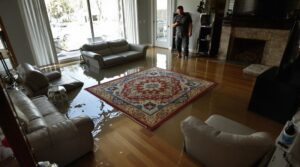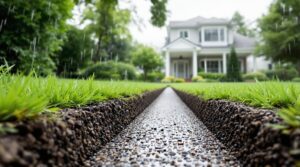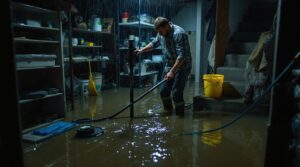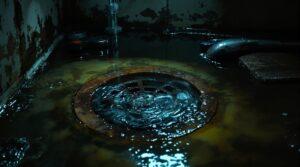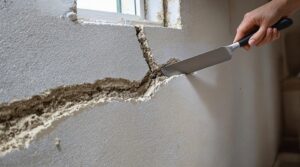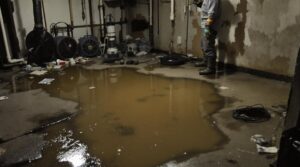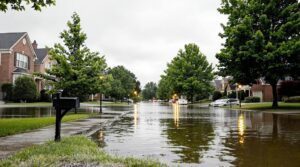Immediate safety measures include shutting off the main water valve and electricity to affected areas. Water removal must begin within 24-48 hours using wet-dry vacuums to prevent mold growth. Documenting all damage through photos and detailed notes supports insurance claims. Professional moisture meters help assess structural damage while dehumidifiers and fans accelerate drying. A public adjuster can maximize claim settlements and guide property owners through complex restoration processes. The following steps guarantee peak recovery from water damage.
Key Takeaways
- Immediately shut off the main water supply and electrical power, then wear protective gear like waterproof gloves before entering flooded areas.
- Document all damage with photos and videos for insurance purposes, creating a detailed inventory of affected items and areas.
- Remove standing water using wet-dry vacuums within 24-48 hours and set up fans and dehumidifiers to prevent mold growth.
- Remove and dispose of water-damaged porous materials like carpet and insulation that cannot be thoroughly dried within 48 hours.
- Consider hiring a public adjuster to handle insurance claims, as they can increase settlement amounts by 20-50% above standard compensation.
Take Immediate Safety Precautions
When a pipe bursts, taking immediate safety precautions is vital to prevent injury and minimize property damage. The most important thing is to address electrical hazards by immediately unplugging all electrical devices and shutting off the main power supply to prevent electrocution risks from standing water.
Locating and turning off the main water shut-off valve is the next important step to stop the flooding from spreading further throughout the property.
Before entering any flooded areas, individuals must verify they are wearing appropriate protective equipment, including waterproof gloves and tall rubber boots, as floodwater may contain harmful contaminants.
If water has reached electrical systems or outlets, it is essential to contact a qualified electrician before attempting any cleanup.
Never enter areas with standing water until confirming that all electrical power has been completely disconnected, as water conducts electricity and poses severe electrocution hazards.
Locate and Stop the Water Source
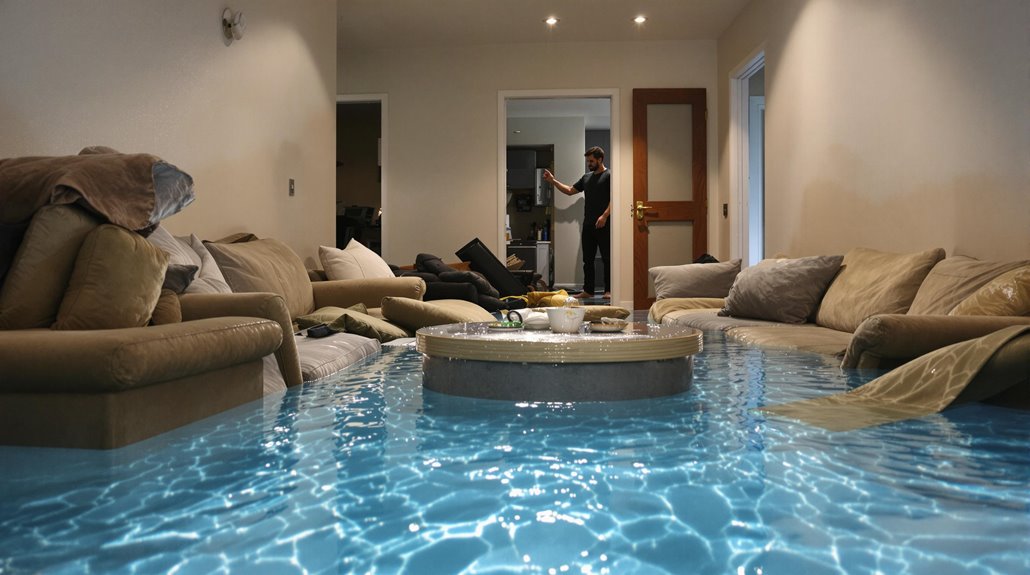
Stopping the flow of water immediately becomes the top priority once safety measures are in place. Homeowners must quickly identify the main water shutoff valve, typically located near the water meter or where the main water supply enters the home. Turn the valve clockwise to halt the water flow throughout the entire house.
| Action | Location | Purpose |
|---|---|---|
| Locate valve | Near water meter | Stop main supply |
| Inspect area | Around burst pipe | Find leak source |
| Apply temp fix | Damaged section | Control flooding |
| Open faucets | Throughout house | Release pressure |
After stopping the main water supply, thoroughly inspect the affected area to locate the source of the water. This may require moving furniture or accessing wall cavities to identify the burst pipe location. Once found, apply temporary measures such as plumber's tape or duct tape to contain the leak until professional repairs can be made. Remember to keep faucets open to relieve pressure and drain remaining water from the system.
Document All Damage for Insurance
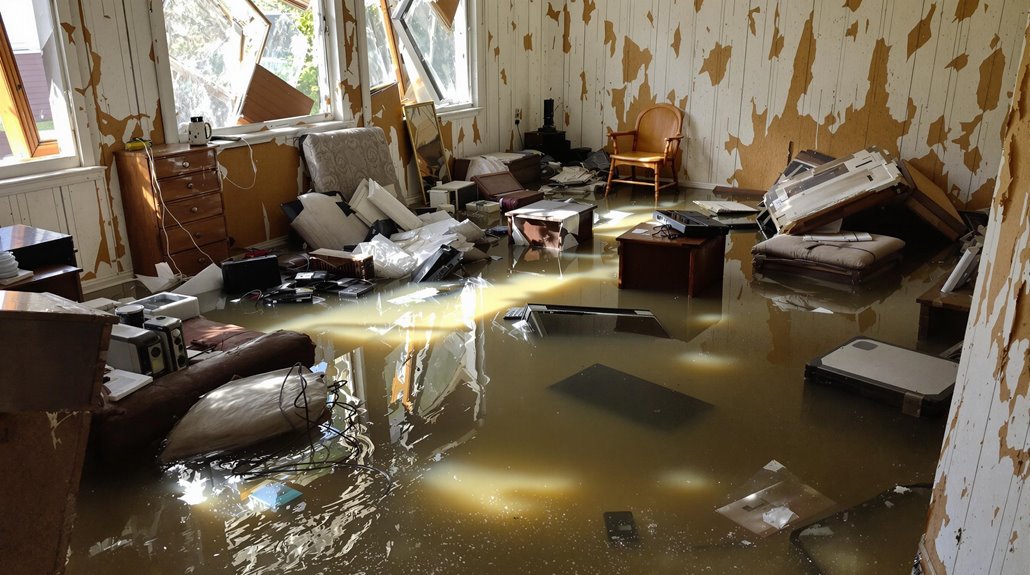
After securing the water source, thorough documentation of all water damage becomes essential for insurance purposes. Homeowners should immediately photograph or video record all affected areas, capturing clear visual evidence of damage to both the structure and personal belongings.
Creating a detailed inventory list is important for the insurance company to process the claim efficiently. This documentation should include approximate values of damaged items, supported by available receipts and purchase records. A thorough assessment should note specific locations of water damage, including affected walls, floors, and personal property.
During water damage restoration, maintaining a chronological record of events is imperative, from the initial pipe burst discovery to the implementation of cleanup measures.
Homeowners should maintain a systematic log of all interactions with insurance representatives, recording names, dates, and conversation summaries. This organized approach to documentation helps guarantee a smoother claims process and maximizes the likelihood of proper compensation.
Remove Standing Water and Wet Items
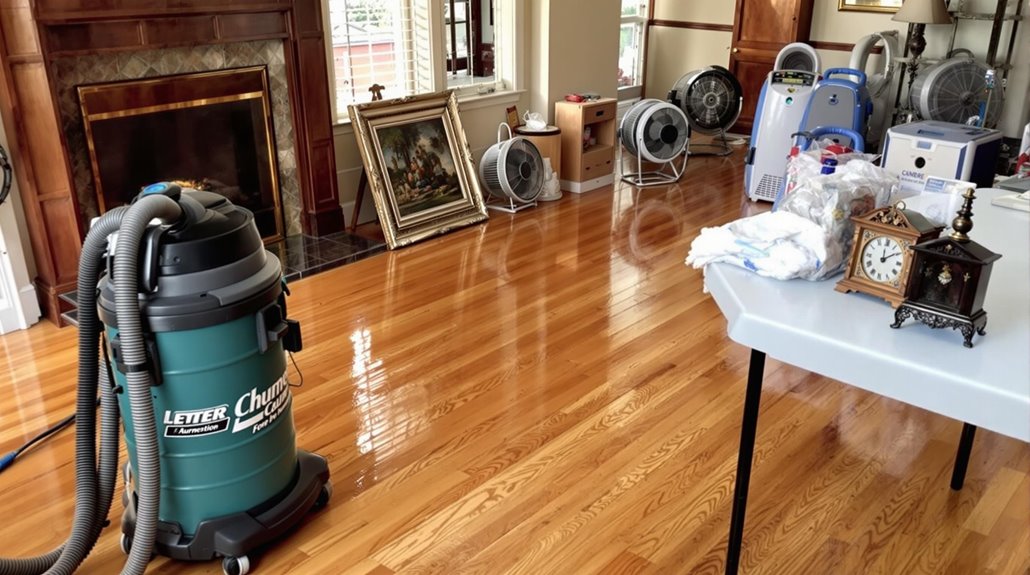
Swift removal of standing water is essential to minimize structural damage and prevent mold growth. The most effective way to remove standing water is by using a wet-dry vacuum, which efficiently extracts water from floors, carpets, and other surfaces.
While the vacuum operates, simultaneously relocate salvageable items to dry areas, prioritizing valuable and irreplaceable possessions.
For hard surfaces, utilize squeegees or mops to direct water toward floor drains, making the water damage cleanup process more systematic and thorough. Once visible water is eliminated, proper drying becomes vital.
Position fans and dehumidifiers strategically throughout the affected space to address moisture trapped in carpets, walls, and other porous materials. During this process, maintaining detailed documentation of all water-damaged items through photographs and written inventory serves dual purposes: tracking progress during cleanup and supporting potential insurance claims.
Begin Professional Drying Process
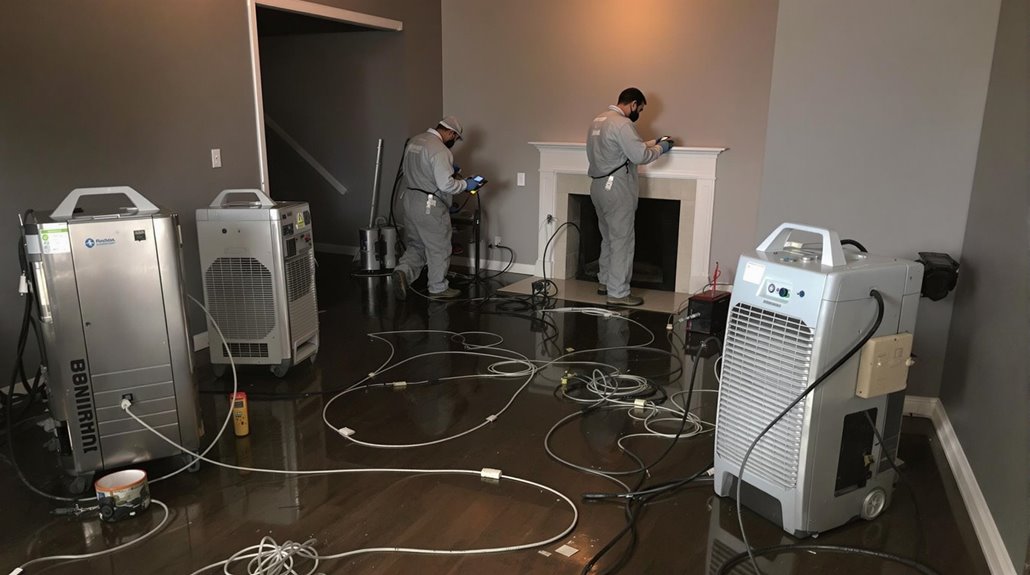
While initial water removal is crucial, engaging professional water damage restoration services marks a significant shift in the recovery process.
These specialists deploy industrial-grade equipment and technical expertise to begin cleaning and thoroughly dry affected areas. The professional drying process must commence within 24-48 hours of water exposure to prevent secondary damage and minimize mold risk.
Key components of professional water damage restoration include:
- Implementation of high-powered dehumidifiers and air movers strategically positioned to accelerate moisture evaporation
- Extensive moisture monitoring of walls, floors, and hidden spaces using specialized detection equipment
- Systematic tracking of drying progress until normal moisture levels are achieved throughout the structure
Restoration professionals guarantee that after they remove standing water, the subsequent drying process addresses both visible and concealed moisture.
This thorough approach prevents future complications and creates ideal conditions for structural repairs and restoration work to proceed effectively.
Prevent Mold Growth and Spread
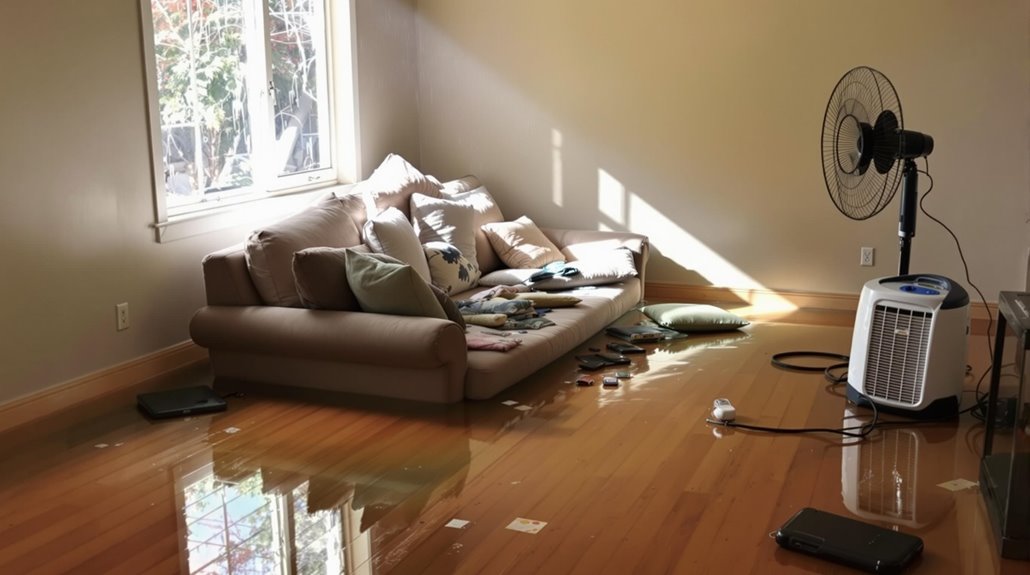
Immediate action within 24 hours of water damage is critical to prevent mold growth, which can begin proliferating in as little as one day after a pipe burst.
Maintaining indoor humidity levels below 60% through dehumidification and proper ventilation creates an environment inhospitable to mold development.
Any wet building materials that cannot be thoroughly dried within 48 hours should be removed and replaced to eliminate potential breeding grounds for mold spores.
Act Within 24 Hours
The critical 24-hour window following a burst pipe determines whether homeowners can prevent substantial mold problems in their property.
Immediate action to remove standing water and control moisture from the air is essential, as mold can begin developing within 24 to 48 hours in water-damaged areas.
To effectively prevent mold growth during this critical period, implement these key measures:
- Deploy wet-dry vacuums immediately to extract standing water from floors, carpets, and hidden spaces.
- Install dehumidifiers strategically throughout affected areas to reduce ambient moisture levels.
- Set up multiple fans and open windows to create cross-ventilation, accelerating the drying process.
These interventions, when implemented promptly, considerably reduce the risk of mold colonization and minimize potential structural damage to the property.
Control Indoor Humidity Levels
Building upon initial water removal efforts, maintaining precise control over indoor humidity levels becomes a central focus in preventing mold proliferation. Effective humidity management requires maintaining levels between 30% and 50% through strategic deployment of dehumidifiers and proper ventilation systems.
| Action | Purpose |
|---|---|
| Install Dehumidifiers | Remove excess moisture from air |
| Monitor Hygrometer | Track real-time humidity levels |
| Use Exhaust Fans | Disperse moisture from daily activities |
| Guarantee Ventilation | Promote air circulation |
| Maintain 30-50% Range | Create inhospitable mold conditions |
Implementing these humidity control measures within the critical 24-48 hour window considerably reduces the risk of mold establishment in water-damaged areas. Regular monitoring guarantees that corrective actions can be taken promptly when humidity levels exceed recommended thresholds, creating an environment where mold cannot thrive.
Remove Wet Building Materials
Swift removal of water-damaged building materials stands as a critical defense against mold proliferation after a pipe burst.
When addressing water damage from a broken pipe, the cleanup process must begin within 24-48 hours to prevent mold growth. After removing standing water, professionals assess and remove compromised materials, cutting drywall at least 12 inches above the water line to guarantee thorough remediation.
- Remove and dispose of porous materials like wet carpet, padding, and saturated insulation that cannot be effectively dried.
- Transport removed materials to outdoor areas or well-ventilated spaces to prevent moisture redistribution.
- Use moisture meters to verify structural components are below 15% moisture content before installing replacement materials.
This systematic approach prevents secondary damage and creates ideal conditions for successful restoration of the affected space.
Repair and Replace Damaged Areas
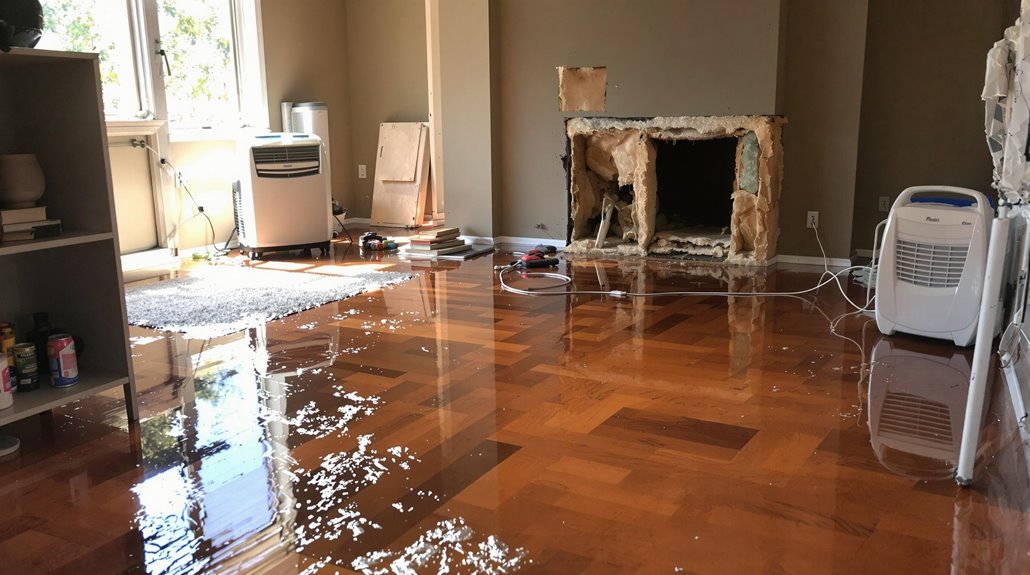
After water damage from a burst pipe has been addressed, homeowners must thoroughly assess and repair affected areas to prevent long-term structural issues. Professional inspection helps identify materials requiring replacement and guarantees proper restoration techniques are implemented.
| Component | Action Required |
|---|---|
| Flooring | Remove saturated materials, dry subfloor |
| Drywall | Cut out damaged sections, replace with new panels |
| Insulation | Replace wet batts with fresh material |
| Plumbing | Repair burst pipe, check adjacent connections |
| Structure | Assess framework integrity, treat for moisture |
The repair process requires systematic replacement of damaged materials with appropriate building components. Homeowners should document all restoration work through photographs and maintain detailed records of repairs, including receipts and contractor information for insurance purposes. A licensed plumber must address the underlying pipe damage before proceeding with structural repairs to prevent future incidents. This all-encompassing approach guarantees the home is restored to a safe, habitable condition while protecting against potential complications from water damage.
Implement Future Prevention Measures
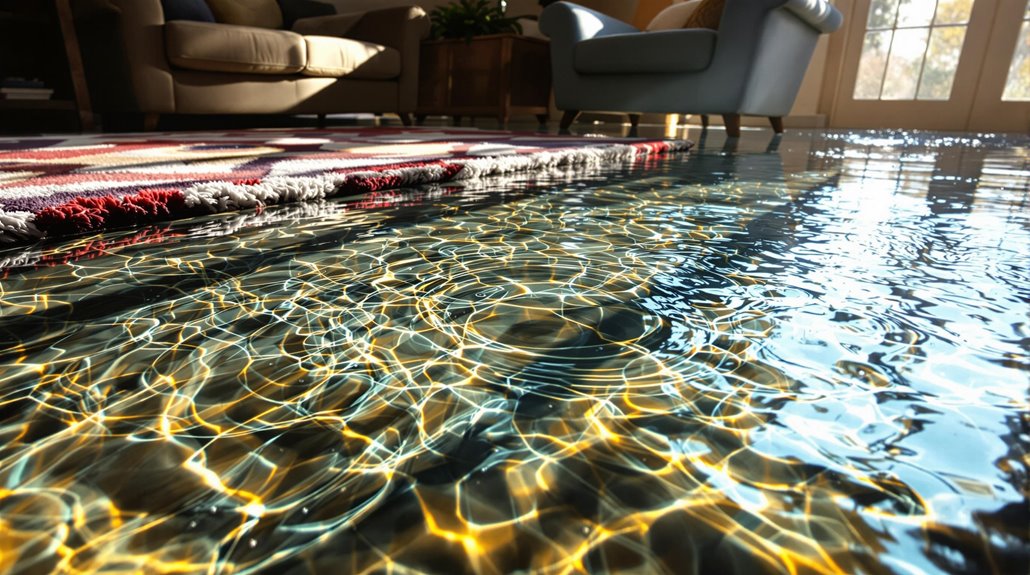
To protect against future plumbing emergencies, homeowners should implement broad preventive measures that minimize the risk of burst pipes and water damage.
Regular inspection and maintenance of plumbing systems can identify potential issues before they escalate into major problems. Installing water leak detection systems provides automated protection by shutting off the main water supply when leaks are detected, while upgrading to high-quality supply hoses reduces the risk of ruptures in appliance connections.
- Confirm all household members can locate and operate critical water shut-off valves for quick response during emergencies.
- Perform systematic plumbing inspections to identify early signs of wear, corrosion, or water leaks.
- Protect basement storage by elevating items and installing moisture sensors in flood-prone areas.
These preventive strategies, combined with modern detection technology and proper maintenance protocols, create a thorough defense system against future water-related incidents, potentially saving thousands in repair costs and preventing extensive property damage.
The Benefits Of Consulting A Public Adjuster
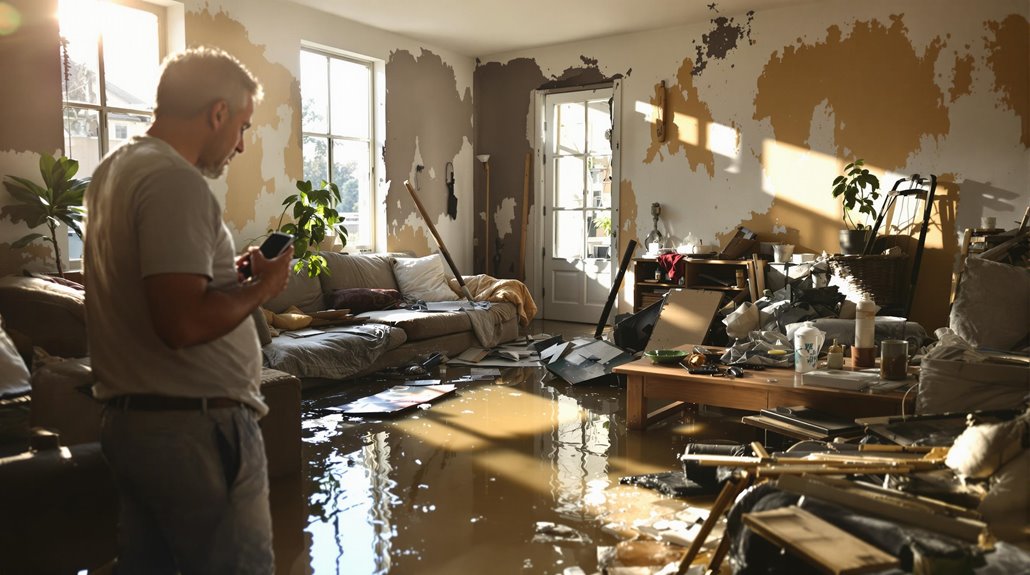
When faced with complex water damage claims from burst pipes, consulting a licensed public adjuster provides critical expertise in maneuvering through insurance policies and documenting losses.
Professional public adjusters conduct thorough, objective assessments of property damage while managing all aspects of the claims process, which reduces stress for property owners and guarantees proper documentation.
Studies demonstrate that utilizing public adjusters often results in considerably higher settlement amounts, with payouts up to 800% more than claims handled without professional representation.
Expertise In Insurance Claims
Managing a burst pipe insurance claim effectively requires specialized knowledge, which is where a public adjuster can prove invaluable. These professionals bring extensive expertise in homeowners insurance claims, ensuring thorough documentation and accurate damage assessments. A public adjuster's understanding of policy language and coverage details enables them to navigate complex claim processes efficiently.
- Claims adjusters analyze market values and construction costs to develop detailed loss estimates that support maximum settlement amounts.
- They maintain current knowledge of insurance regulations and industry standards to strengthen claim negotiations.
- Public adjusters document all aspects of water damage thoroughly, including hidden issues that could lead to future problems.
While their services typically cost 10-20% of the settlement, their expertise often results in higher payouts that justify the investment, particularly in complex water damage scenarios.
Objective Damage Assessment
An objective damage assessment conducted by a public adjuster serves as the cornerstone of a successful burst pipe insurance claim. These professionals meticulously document all damage from burst pipes, including hidden issues that might escape initial detection.
Their thorough evaluation guarantees that homeowners receive complete compensation for both obvious and concealed damages.
When consulting a public adjuster, property owners benefit from expert analysis based on industry standards and current market rates. These specialists possess the technical knowledge to accurately assess structural damage, personal property loss, and potential long-term implications of water damage.
Their detailed documentation and professional assessment strengthen the claim's validity, often resulting in notably higher settlement amounts compared to self-managed claims.
This expertise proves particularly valuable in complex cases where extensive water damage requires substantial restoration work.
Streamlined Claim Process
The efficiency of working with a public adjuster greatly accelerates the insurance claim process after a burst pipe incident.
These professionals possess extensive knowledge of insurance policies and documentation requirements, enabling them to navigate complex claim procedures effectively. Their expertise typically results in higher settlement amounts, despite their fee of 5-15% of the total claim.
- Public adjusters conduct thorough damage assessments, guaranteeing no details are overlooked during the documentation phase.
- They handle direct negotiations with the insurance company, reducing stress and time investment for the property owner.
- Their involvement minimizes common errors that could lead to claim denials or processing delays.
This streamlined claim process proves particularly valuable when dealing with extensive water damage, as public adjusters guarantee proper documentation and advocate for fair compensation throughout the settlement process.
Higher Claim Payouts & Settlements
Public adjusters consistently deliver higher claim payouts compared to self-managed insurance claims, with settlements typically ranging 20% to 50% above standard compensation amounts. Their contingency-based compensation structure guarantees dedication to maximizing recoveries for flood damage and other losses.
These professionals excel at thorough documentation of damages, including often-overlooked aspects such as future repairs and loss of use expenses. Their expertise in policy interpretation enables them to identify additional coverage provisions that benefit homeowners, guaranteeing maximum compensation for their clients.
Through detailed analysis and professional negotiations, public adjusters leverage their industry knowledge to secure advantageous settlements while removing the burden of claims management from property owners. This allows homeowners to focus on recovery while professionals handle the technical aspects of claim documentation and negotiation.
About The Public Claims Adjusters Network (PCAN)
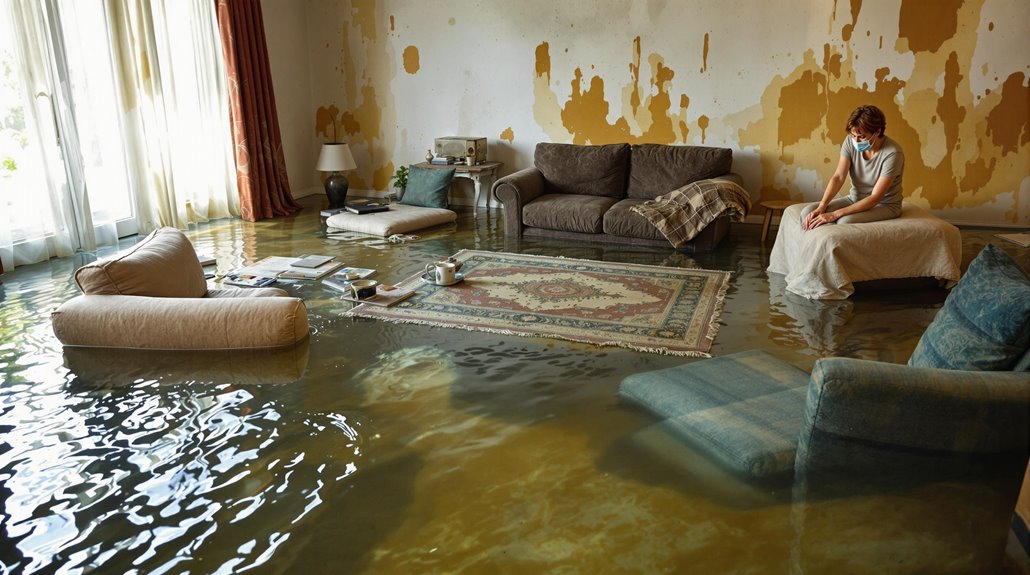
Professional assistance for insurance claims can be found through the Public Claims Adjusters Network (PCAN), a nationwide organization of state-licensed public adjusters serving over 40 states.
PCAN members specialize in residential and commercial property damage insurance claims, including water damage from burst pipes. These experts undergo rigorous vetting and must maintain the highest professional standards through yearly audits.
PCAN guarantees quality representation for policyholders by:
- Requiring all member adjusters to pass an intensive application and interview process
- Verifying current state licensing and monitoring for any complaints
- Maintaining strict ethical and professional standards through mandatory annual reviews
The network connects property owners with pre-vetted public adjusters who have demonstrated expertise in over 30 different claim types.
For those facing water damage from burst pipes, PCAN provides access to qualified professionals who understand the complexities of insurance claims and can effectively advocate for proper settlements.
Frequently Asked Questions
What Should Be Done Immediately if a Water Line in Your Home Bursts?
Emergency response requires immediate water shut off at the main valve, followed by disconnecting electrical power. Conduct rapid damage assessment while documenting affected areas for insurance purposes.
Does Homeowners Insurance Cover a Burst Pipe?
Homeowners insurance typically covers burst pipe damage, subject to policy coverage limits. Filing a claim process requires proper documentation. Insurers may review preventive measures taken to maintain plumbing system integrity.
How Do You Dry Out a House After a Burst Pipe?
Effective water extraction techniques require wet-dry vacuums and dehumidifiers. Professional drying equipment options include commercial air movers. Implementing proper mold prevention strategies demands thorough ventilation and moisture monitoring below 60% humidity.
What Happens if a Pipe Bursts Under Your House?
Like a ticking time bomb, a burst pipe releases destructive forces beneath homes, causing extensive flooding, structural damage, and costly repairs. Swift detection and professional intervention prevent catastrophic water damage.
Final Thoughts
Burst pipes can release catastrophic volumes of water – up to 100 gallons per hour – causing devastating structural damage within minutes. By following proper emergency protocols, documenting extensively, and partnering with qualified public adjusters, property owners can transform even severe flooding disasters into fully restored spaces. Professional claims handling often results in settlements 40-70% higher than self-filed claims, making it a critical step in the recovery process.
For homeowners dealing with property damage claims related to their homeowners insurance policy, insurance industry insiders and legal experts strongly advise contacting a qualified state-licensed public adjuster. Public adjusters work exclusively for policyholders, not insurance companies, serving as dedicated advocates throughout the claims process. These state-licensed professionals help navigate complex insurance policies, identify hidden damages often unknown to policyholders, thoroughly document losses, and negotiate with insurance companies to ensure fair settlements while protecting policyholder rights.
By engaging a public adjuster, homeowners can maximize their claim payouts, expedite the claims process, and reduce the stress of dealing with insurance companies, allowing them to focus on recovery. Policyholders interested in discussing their property damage or loss claims can request a no-obligation free consultation with a Public Claims Adjusters Network (PCAN) member public adjuster through our contact page.
